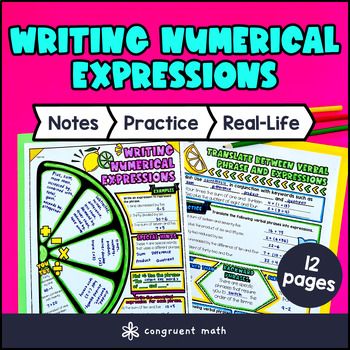Want more ideas and freebies?
Get my free resource library with digital & print activities—plus tips over email.
Join for Free Resources →
$4.25
Ever wondered how to teach writing numerical expressions in an engaging way to your 5th or 6th-grade students? Thinking of how to explain steps to translate between verbal phrase and expressions?
In this lesson plan, students will learn about writing numerical expressions and their real-life applications. Through artistic, interactive guided notes, check for understanding, practice coloring worksheet, and a maze worksheet, students will gain a comprehensive understanding of writing numerical expressions.
The lesson ends with a real-life example that explores how writing numerical expressions are used in practical everyday math situations.

$4.25
After this lesson, students will be able to:
Before this lesson, students should be familiar with:
As a hook, ask students why writing numerical expressions is important in real-life situations.
Use the first page of the guided notes to introduce the concept of writing numerical expressions using keywords for addition and subtraction. Walk through the key points of identifying keywords that signals specific operations (i.e. sum, difference, product, quotient, etc) and translating them into numerical expressions. Students will be filling in keywords on the guided notes while you teach.
Use the second page of the guided notes to practice translating between verbal phrase and expressions. There are multiple sections on the page to allow for students to apply the keywords they've just learned about on page 1.
Use the third page of the guided notes to introduce writing numerical expressions with whole-number exponents. Walk through the key points of understanding exponents, keywords (i.e. squared, cubes) and incorporating them into numerical expressions.
Based on student responses during the introduction, reteach concepts that students need extra help with. If your class has a wide range of proficiency levels, you can pull out students for reteaching, and have more advanced students begin working on the practice exercises.
Have students practice writing numerical expressions using the practice worksheet provided in the resource(pg. 2-3) as well as the maze activity (pg. 4). Walk around to answer student questions.
Fast finishers can dive into the color by number activity (pg. 5) for extra practice. You can alternatively assign it as homework for the remainder of the class.
Using the last page of the guided notes (pg. 6), bring the class back together, and introduce the concept of writing and using numerical expressions in real-life scenarios, such as calculating expenses for a school trip or modeling the cost of running a small business.
Students read about scenarios where writing numerical expressions can be helpful in real life as well as complete a short self assessment on the mastery of this math topic.
If you’re looking for digital practice for writing numerical expressions, try my Pixel Art activities in Google Sheets. Every answer is automatically checked, and correct answers unlock parts of a mystery picture. It’s incredibly fun, and a powerful tool for differentiation.
Here’s one activity to explore:
A fun, no-prep way to practice writing numerical expressions is Doodle Math — they’re a fresh take on color by number or color by code. It includes multiple levels levels of practice, perfect for a review day or sub plan.
Here are 1 activities to try:
Writing numerical expressions helps simplify and represent mathematical operations in a concise form, making complex problems easier to solve and understand.
Expressions are mathematical phrases that can contain variables, while equations show a relationship between two expressions using an equal sign.
Keywords like "sum," "difference," "product," and "quotient" are commonly used to represent addition, subtraction, multiplication, and division in numerical expressions.
Exponents represent how many times a number is multiplied by itself. They help simplify repeated multiplication in numerical expressions.
The order of operations (PEMDAS: Parentheses, Exponents, Multiplication and Division from left to right, Addition and Subtraction from left to right) ensures that calculations are done correctly in numerical expressions.
You can use activities like budgeting, recipe scaling, and distance-time calculations to help students practice writing numerical expressions based on real-world scenarios.
Provide scaffolded notes, graphic organizers, and interactive activities to break down the concept step by step and offer multiple opportunities for practice and reinforcement.
Get my free resource library with digital & print activities—plus tips over email.
Join for Free Resources →